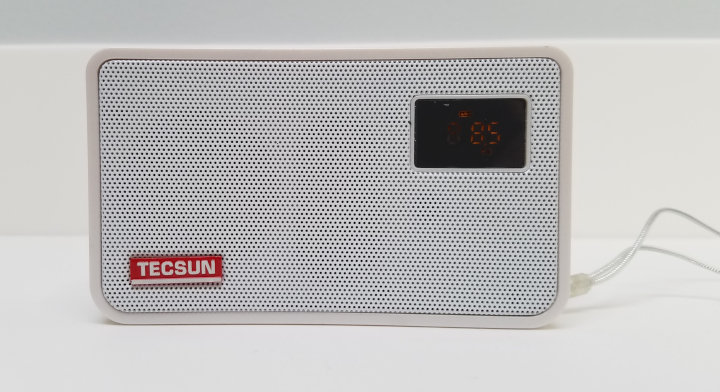
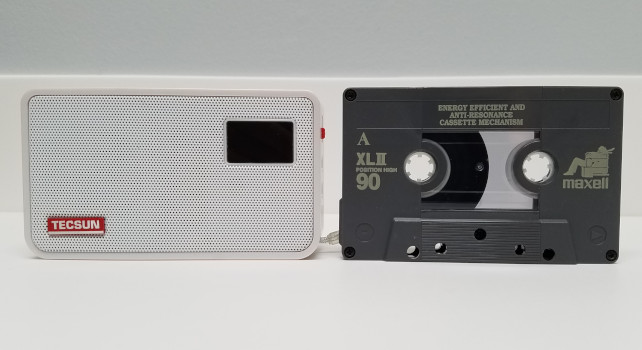
Starting in 2020, I began to find cheap and easily available electronic devices that were more than just radios. In fact, their capabilities as radios sometimes took a back seat to other functions.
The Tecsun ICR-100 is one such device. It's an FM radio, an MP3 player, an MP3 recorder, and has a surprisingly powerful two-way speaker system for a radio its size. Media files (MP3, WAV, WMA) are stored on a Micro SD card. One is supplied, but you can replace it with a card that has capacity, up to 32 GB. The ICR-100 also has a line input allowing you to use the speaker with a cellphone, tablet, or computer. That line input also allows the ICR-100 to record audio from an external source.
In some ways, the Tivdio V-115 could be considered a precursor to a device such as the Tecsun model. The Tivdio is a multiband radio with numerous playback and recording features. The Tecsun ICR-100 offers a more limited set of capabilities and only FM radio reception is supported. However, I found it easier to use than the Tivdio unit.
The display is also quite different from a DSP-based radio. It uses LEDs rather than LCDs (making the display hard to photograph) and shows a very limited amount of information. When using the FM radio or the media player, the display turns off after 10 seconds to conserve battery power. The battery indicator is much simpler than a typical DSP radio: there's one icon to show that no charging is required and another that shows that less than a third of the unit's battery power remains, indicating that charging is needed.
The controls of the ICR-100 resemble those of portable tape recorders and players. As you can see on the right at the top of this page, it's about the height and width of a cassette tape! It's much thicker than a cassette tape, though.
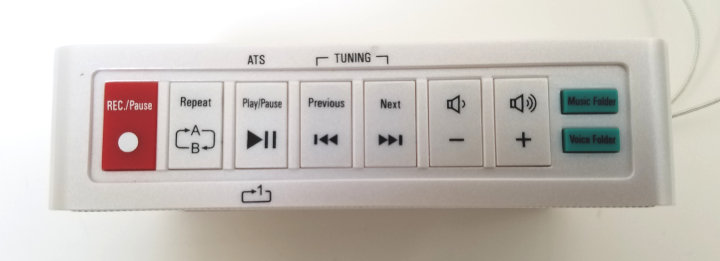
Most of the controls are on the top of the unit (see left). They're reminiscent of the "piano-key" controls used by many cassette recorders and players way back when. They're clearly a better fit for maneuvering through media files than a radio dial. The button to start a recording is prominently displayed. The small gray buttons on the right let you toggle between playing back files recorded from the ICR-100's built-in microphone and files recorded either from the radio or the line input. The volume controls for the speaker and headphone jack are next to those two buttons.
The Previous and Next buttons in the center of the ensemble are also used for tuning the FM radio. This is where you will encounter some significant limitations. The only way that you can tune the radio is through those buttons which step through station memories. But the only way to set up those station memories is to use the ATS function. That's done by pressing the Play/Pause key.
The radio uses the clear plastic carrying strap, which has a wire running through it, as an antenna. This results in less sensitivity than the radio would otherwise have. The radio can be set to tune either from 76 to 108 MHz, to include the Japanese FM band; or from 87 to 108 MHz, for the rest of the world. This is done by pressing and holding the gray MUSIC button while the radio is on.
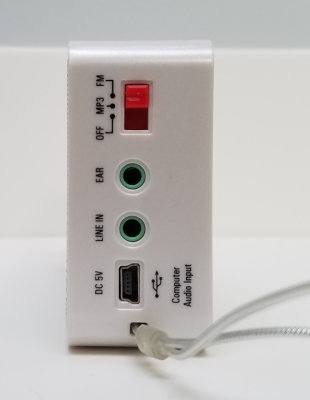
A power and function switch is on the right side of the unit, selecting between the unit's media-player and radio functions. A miniature (not "micro"!) USB jack provides power for charging the lithium-ion battery and also allows the micro SD card in the radio to be mounted on a computer as an external drive under the name "Buildwin Media Player".
There are two standard 3.5mm stereo jacks, one for a headphone (called an "earphone" - retro!) and one for line-in. Anything plugged into the line-in jack takes precedence over the radio. This is true for both the speaker and for the recording function. There is also a built-in microphone than can be used for recording. It's activated when the power and function switch is in the MP3 position. The ICR-110 records in stereo, except when the microphone is being used. Recordings from the microphone are in mono.
There's no Bluetooth reception or transmitting capability for the ICR-100.
Just as the FM radio has some limitations when navigating between stations, the media player in the ICR-100 also has limited options for navigating among media files. For the most part, you can only go through the files with the Previous and Next buttons. There's no provision for random (shuffle) play. There are also no options for audio equalization or any other kind of control over the sound quality. There are no tone controls, either for the media player or for the FM radio.
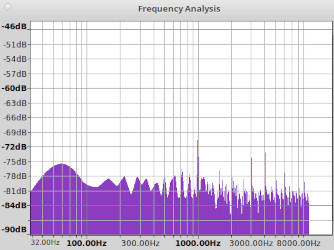
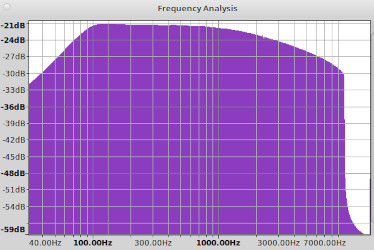
The recording function also has some limitations. It only records in the MP3 format, and while it uses a reasonable bit rate of 128 kbps, the sample rate is 32 kHz instead of a more standard 44.1 kHz. This puts an upper bound of 16 kHz on the frequency response. This is OK for recording FM radio, since FM's frequency response is limited above 15 kHz anyway to avoid interfering with the 19 kHz "pilot tone" that enables FM stereo reception. But there's more to the story.
A low-pass "brickwall" filter is also employed to limit upper frequency response to around 10 kHz (near right). Frequency response is down 50 dB at 11 kHz, -58 dB at 12 kHz, and -65 dB at 15 kHz. The use of such a low-pass filter is a decision I just don't understand. There's no need for such a filter for recording FM radio since the sample rate already limits the upper frequency-response boundary. For recording from the line input, such a filter makes even less sense. You end up making a lesser-quality recording than you otherwise would have had.
There may also be some issues with residual noise from the electronics used in the unit. The graph at far right shows that random noises are generated when recording with the ICR-100. These are at a very low level, no more than -72 dB by my estimation, but may still be a concern for recording very quiet material.
Considering these issues, what would the recorder be good for? Probably convenience more than anything else. For example, it would be a quick and easy way of making FM airchecks, though some might hear slightly degraded frequency response. I wouldn't try to use it to make professional-quality recordings.
To be fair, the Tivdio V-115 has similar limitations, though with a lower noise floor, a higher upper boundary for frequency response (about 13.7 kHz), a more standard sampling rate, and three quality options rather than just one. The Tivdio (also known as the Retekess V115) is cheaper, too - $25 versus the ICR-100's typical price of $35. Given Tecsun's generally good reputation for quality, it's hard to understand why Tecsun has put these artificial limitations on the ICR-100's recording functions.
Note that the brickwall filter is not employed for playback, so media files you've recorded elsewhere should have no problems on the ICR-100 as long as they're in one of the supported formats.
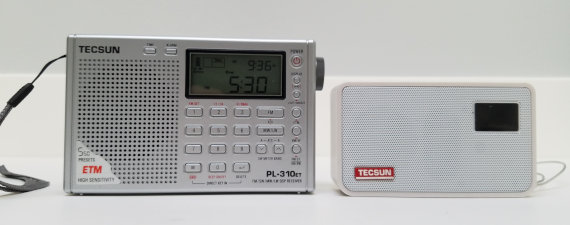
As for the ICR-100's FM radio, Tecsun does not call it a DSP (Digital Signal Processing) radio (unlike, for example, the PL-310ET, pictured at left with the ICR-100 for a size comparison). The owner's manual is silent on the matter. It's also hard to compare the ICR-100's FM radio performance with other radios given the inability to listen to stations other than those stored into memory.
I can say that the ATS function picked up 44 signals at my San Francisco Bay Area location, where usually 45 to 50 stations can be received. Even discounting a couple of false signals, this is a reasonable level of performance, especially considering the use of the carrying strap as an antenna.
The sound quality from the radio is surprisingly good for its size. It sounds especially good through headphones, with stereo separation being better than I've encountered on most DSP-based radios. That's one reason why I think this may not be a DSP-based radio. The speaker system is especially notable: it's a two-way system with a small woofer to supplement the main speaker. The owner's manual says the radio has a 3-watt amplifier. I haven't measured it, but there's plenty of volume for sure. The quality of the speaker system makes the line-input function particularly useful. One downside is that the speaker produces only mono sound, but I feel this is minor, considering the fact that many modern radios with one speaker provide stereo sound at their headphone output, and this is no different.
Another possible downside is the use of a lithium-ion battery to charge the radio. Fortunately, this radio uses a BL-5C battery, which I have found to be stable and a good choice for radios. As mentioned toward the start of this review, a mini USB connection is used to provide power to recharge the battery.
To summarize, the ICR-110 provides a wide range of features, albeit with some limitations, especially in recording, with the standouts being the quality of the built-in speaker, the ease of use, and the number of functions it can perform. Even with the lithium-ion battery, it could be a handy traveling companion, packing a lot of sound into a small package, with recording and playback features that may be convenient, though accompanied by some compromises.